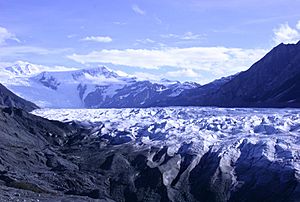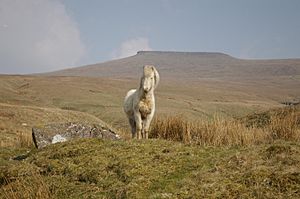Natural landscape facts for kids
A natural landscape is the original land that exists before people change it. Think of it as how a place looks without human buildings, roads, or farms. The natural landscape is different from the cultural landscape, which is shaped by human activity.
Today, it's hard to find any place on Earth that hasn't been touched by humans in some way. So, when we talk about a natural landscape, we often mean how "natural" it still feels.
For example, in her book Silent Spring (1962), Rachel Carson described how a roadside used to look: "Along the roads, laurel, viburnum and alder, great ferns and wildflowers delighted the traveler’s eye through much of the year." Then she showed how it changed after chemicals were used: "The roadsides, once so attractive, were now lined with browned and withered vegetation as though swept by fire." Even if a place has been changed a little, we can still imagine what its natural state might have been.
The idea of a "natural landscape" first came from landscape painting and landscape gardening. It was used to describe a style that looked more like nature, rather than a very formal, planned garden. Later, a famous explorer and scientist named Alexander von Humboldt (1769 – 1859) helped people think about natural landscapes as separate from cultural landscapes. In 1908, a geographer named Otto Schlüter used the terms Urlandschaft (original landscape) and Kulturlandschaft (cultural landscape) to help explain these ideas in geography.
Contents
What is a Natural Landscape?
The term "natural landscape" is often used by scientists to describe the biological, geological, and climate features of an area. It focuses on the physical world, like plants, animals, mountains, and rivers, rather than human ideas or feelings about a place.
Sometimes, "natural landscape" is used like the word wilderness. However, for geographers, a natural landscape is a scientific term. It describes the physical parts of a landscape, not the cultural ideas linked to "wilderness."
Nature and Conservation
The words "nature" and "natural" can have different meanings. One common meaning is "the physical world, including plants, animals, and the land, as opposed to humans or human creations." This idea often sees humans as separate from nature.
However, modern science, especially since Charles Darwin, helps us understand that humans are also part of nature. This means we are connected to the natural world, not completely separate from it.
Conservation in America
How Americans think about "natural" areas has changed over time, especially in the conservation movement.
In the mid-1800s, people in America started to notice that wild lands were shrinking and wildlife was disappearing. This led to the creation of American National Parks and other protected areas. At first, people thought that to protect these places, they just needed to stop things like logging, grazing, or fires.
For example, in Yellowstone Park, the original plan changed the park's natural balance. Native Americans were removed, and later, almost all the wolves were killed.
About a hundred years later, in the mid-1900s, people realized that simply protecting parks from disturbance wasn't enough. They saw that sometimes, humans needed to step in to help restore the landscape to its "natural" state. The Leopold Report in 1963 suggested that "A national park should represent a vignette of primitive America." This new idea eventually led to the return of wolves to Yellowstone Park in the 1990s.
However, recent studies show that a truly untouched or "primitive" natural landscape is very rare. Humans have been changing landscapes for a very long time. Even places that seem wild have often been influenced by people. This makes it harder to decide what is truly "natural" and how to protect it. The discovery of global warming also adds to this challenge, as it changes natural landscapes in new ways.
Some experts now argue that nature and culture are not completely separate. They believe that "wildness" can be found anywhere, even in a city. This means that even a tree in a garden, though planted by humans, still has its own wild, natural qualities.
Conservation in Europe
The landscape of Europe has been greatly changed by people over many centuries. Even in areas with few people, like the Cairngorm Mountains in Scotland, only the highest peaks are truly natural. The Cairngorms no longer have wolves, bears, wild boar, or lynx. The Scots pine forests, known as the Caledonian forest, used to cover much more of Scotland than they do today.
The Swiss National Park is a good example of a more natural landscape in Europe. It was created in 1914 and is one of Europe's oldest national parks. Visitors must stay on roads or paths and are not allowed to make fires or camp. The only building inside the park is a mountain hut called Chamanna Cluozza. It is also forbidden to bother animals or plants, or to take anything from the park. Dogs are not allowed. Because of these strict rules, the Swiss National Park is the only park in the Alps that the IUCN (International Union for Conservation of Nature) has called a strict nature reserve. This is the highest level of protection.
History of Natural Landscapes
No place on Earth is completely untouched by people and their culture. Humans are part of biodiversity, but our activities affect biodiversity. This, in turn, changes the natural landscape. People have changed the land so much that very few places remain truly wild. However, if human influences are removed, a landscape can often return to a natural or almost natural state.

Even remote areas like the Yukon and Alaskan wilderness are not free from human influence. The huge Kluane-Wrangell-St. Elias-Glacier Bay-Tatshenshini-Alsek park system, a UNESCO World Heritage Site, is home to First Nations people. They have lived in this region for a very long time. Through agreements with the Canadian Government, they have legal rights to hunt and gather in these areas.
How Landscapes Are Shaped
Over long periods, natural landscapes are shaped by many forces. These include tectonics (how the Earth's crust moves), erosion (wearing away of land by wind or water), weathering (breaking down of rocks), and vegetation (the plants that grow there).
Examples of Human Influence on Landscapes
Human activities, whether on purpose or by accident, change the landscape. Cultural landscapes are places or things created and maintained by people. Here are some ways humans change a landscape:
- Building fences, roads, and parking lots.
- Creating sand pits and buildings.
- Making hiking trails.
- Managing plants, like bringing in invasive species (plants that don't belong there and can harm native ones) or removing plants.
- Managing animals, hunting, or mining.
- Practicing natural landscaping, farming, and forestry.
- Causing pollution.
Areas that might look natural but are actually cultural landscapes include public parks, farms, orchards, artificial lakes, managed forests, golf courses, and gardens.

See also
 In Spanish: Espacio natural para niños
In Spanish: Espacio natural para niños
- Cityscape
- Intact forest landscape
- Land restoration
- Land use
- Landscape art
- National Parks
- Natural environment
- Natural heritage
- Rewilding (conservation biology)
- Romantic movement
- Seascapes
- Skyscape art
- Soundscape

